
Matomo is a free and open source web analytics application developed by a team of international developers that runs on a PHP/MySQL webserver. It tracks online visits to one or more websites and displays reports on these visits for analysis. It’s very similar to Google Analytics, but you can host it on your Synology NAS. In this step by step guide I will show you how to install Matomo on your Synology NAS using Docker & Portainer. Note: You can also use Umami or Plausible on your Synology NAS as alternative to Matomo.
STEP 1
Please Support My work by Making a Donation.
STEP 2
Install Portainer using my step by step guide. If you already have Portainer installed on your Synology NAS, skip this STEP. Attention: Make sure you have installed the latest Portainer version.
STEP 3
Make sure you have a synology.me Wildcard Certificate. Follow my guide to get a Wildcard Certificate. If you already have a synology.me Wildcard certificate, skip this STEP.
STEP 4
Go to Control Panel / Login Portal / Advanced Tab / click Reverse Proxy. Follow the instructions in the image below.

STEP 5
Now click the “Create” button. Follow the instructions in the image below.
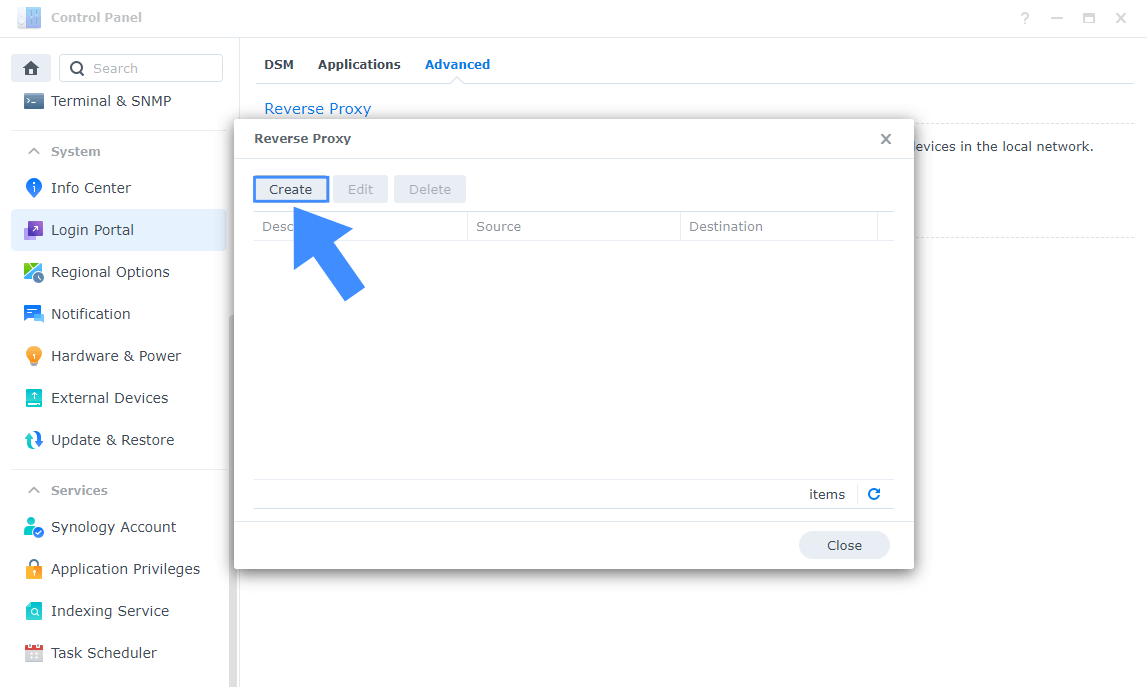
STEP 6
After you click the Create button, the window below will open. Follow the instructions in the image below.
On the General area, set the Reverse Proxy Name description: type in matomo. After that, add the following instructions:
Source:
Protocol: HTTPS
Hostname: matomo.yourname.synology.me
Port: 443
Check Enable HSTS
Destination:
Protocol: HTTP
Hostname: localhost
Port: 8597

STEP 7
On the Reverse Proxy Rules, click the Custom Header tab. Click Create and then, from the drop-down menu, click WebSocket. After you click on WebSocket, two Header Names and two Values will be automatically added. Click Save. Follow the instructions in the image below.

STEP 8
Go to Control Panel / Network / Connectivity tab/ Check Enable HTTP/2 then click Apply. Follow the instructions in the image below.

STEP 9
Go to Control Panel / Security / Advanced tab/ Check Enable HTTP Compression then click Apply. Follow the instructions in the image below.

STEP 10
Go to File Station and open the docker folder. Inside the docker folder, create one new folders and them matomo. Follow the instructions in the image below.
Note: Be careful to enter only lowercase, not uppercase letters.

STEP 11
Now create two new folders inside the matomo folder that you have previously created at STEP 10 and name them data and db. Follow the instructions in the image below.
Note: Be careful to enter only lowercase, not uppercase letters.

STEP 12
Right click on the matomo folder that you have previously created at STEP 10, then click Properties. Follow the instructions in the image below.

STEP 13
Go to the Permission tab, then click Advanced options. From the drop-down menu, choose “Make inherited permissions explicit“. Follow the instructions in the image below.

STEP 14
Select Everyone then click the Edit tab. Follow the instructions in the image below.
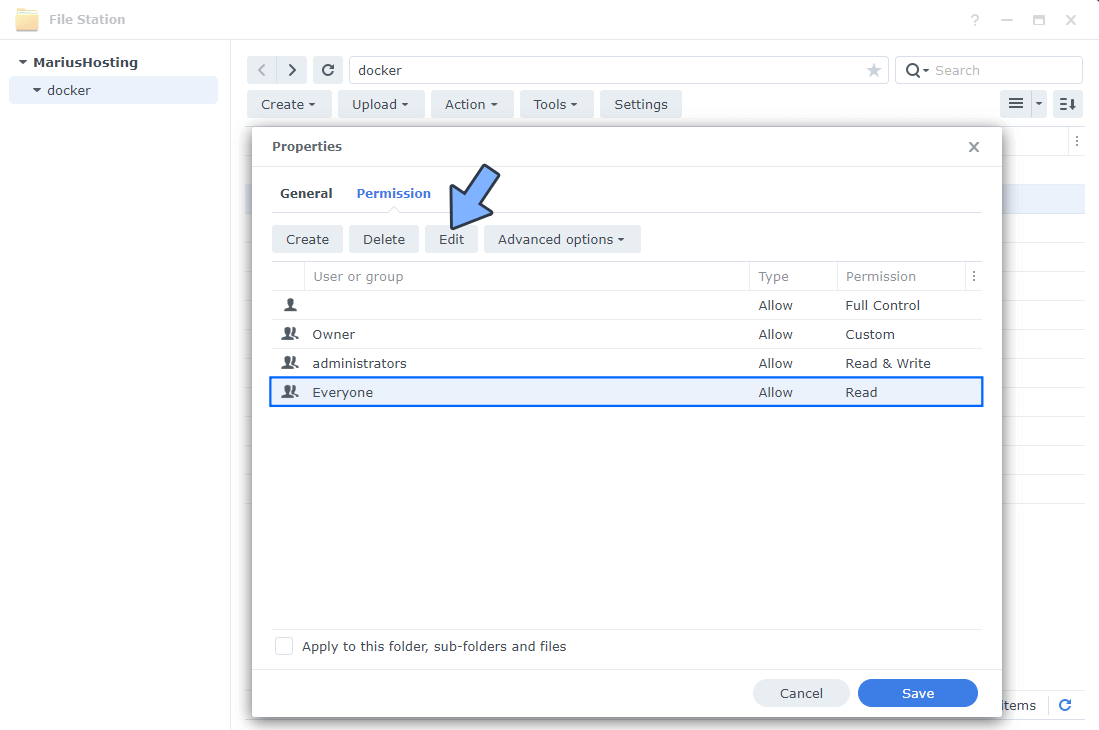
STEP 15
Check all Read and Write Permissions. Click Done. Follow the instructions in the image below.

STEP 16
After you click Done on STEP 15, check “Apply to this folder, sub-folders and files“. Click Save. Follow the instructions in the image below.

STEP 17
Log into Portainer using your username and password. On the left sidebar in Portainer, click on Home then Live connect. Follow the instructions in the image below.

On the left sidebar in Portainer, click on Stacks then + Add stack. Follow the instructions in the image below.

STEP 18
In the Name field type in matomo. Follow the instructions in the image below.
services:
db:
container_name: Matomo-DB
hostname: matomo-db
image: mariadb:11.4-noble #LTS Long Time Support Until May 29, 2029.
command: --max_allowed_packet=1073741824
restart: on-failure:5
volumes:
- /volume1/docker/matomo/db:/var/lib/mysql:rw
environment:
MARIADB_ROOT_PASSWORD: matomopass
MARIADB_DATABASE: matomodb
MARIADB_USER: matomouser
MARIADB_PASSWORD: matomopass
TZ: Europe/Bucharest
matomo:
container_name: Matomo
image: matomo:latest
healthcheck:
test: timeout 10s bash -c ':> /dev/tcp/127.0.0.1/80' || exit 1
interval: 10s
timeout: 5s
retries: 3
start_period: 90s
environment:
PUID: 1026
PGID: 100
TZ: Europe/Bucharest
MATOMO_DATABASE_HOST: matomo-db
MATOMO_DATABASE_USERNAME: matomouser
MATOMO_DATABASE_PASSWORD: matomopass
MATOMO_DATABASE_DBNAME: matomodb
ports:
- 8597:80
depends_on:
- db
volumes:
- /volume1/docker/matomo/data:/var/www/html:rw
restart: on-failure:5
Note: After you paste the code in the Web editor, change the value for TZ. (Select your current Time Zone from this list.)
Note: After you paste the code in the Web editor, change the value numbers for PUID and PGID with your own values. (Follow my step by step guide on how to do this.)
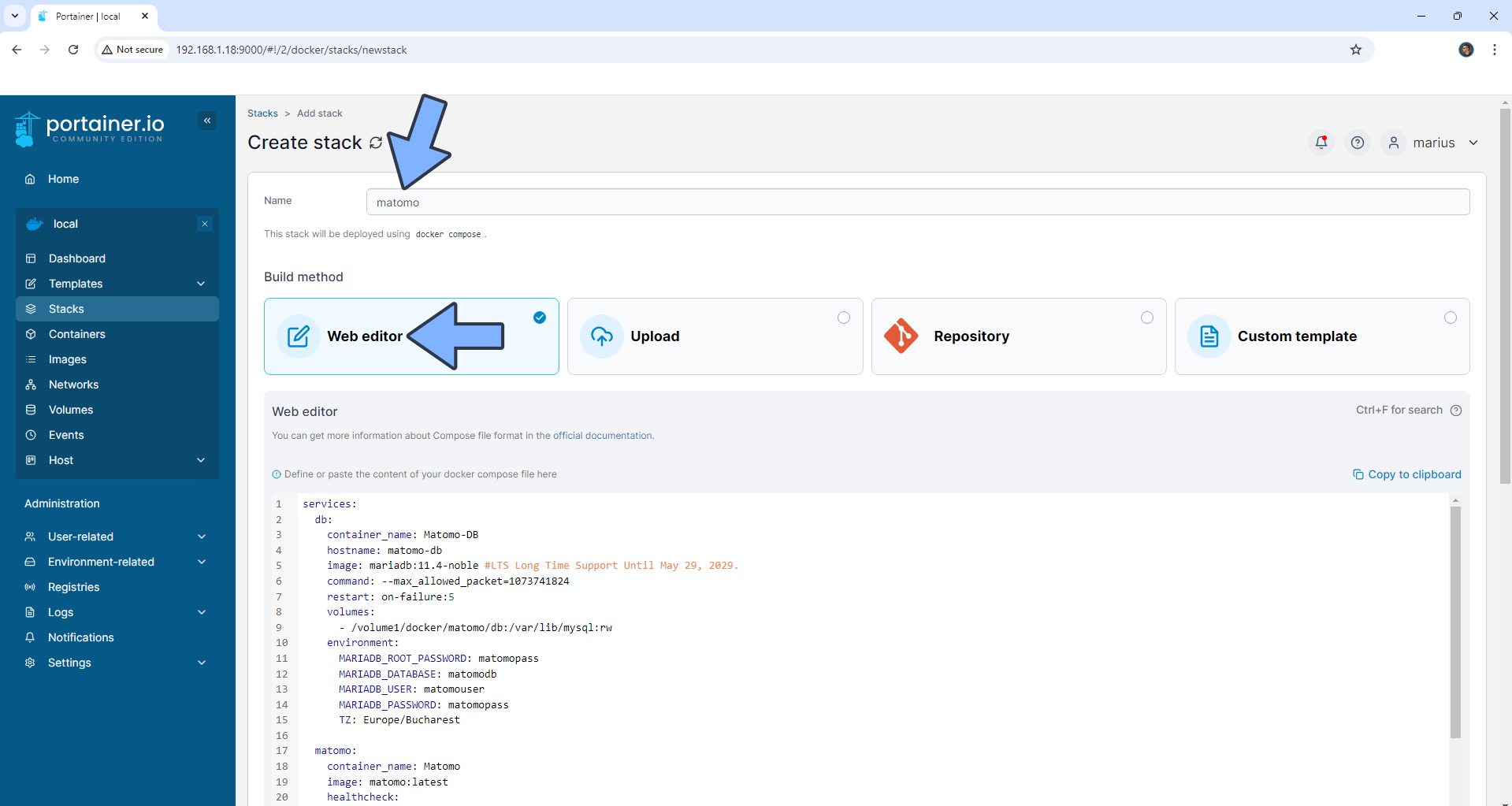
STEP 19
Scroll down on the page until you see a button called Deploy the stack. Click on it. Follow the instructions in the image below. The installation process can take up to a few minutes. It will depend on your Internet speed connection.

STEP 20
If everything goes right, you will see this message at the top right of your screen: “Success Stack successfully deployed“.

STEP 21
🟢Please Support My work by Making a Donation. Almost 99,9% of the people that install something using my guides forget to support my work, or just ignore STEP 1. I’ve been very honest about this aspect of my work since the beginning: I don’t run any ADS, I don’t require subscriptions, paid or otherwise, I don’t collect IPs, emails, and I don’t have any referral links from Amazon or other merchants. I also don’t have any POP-UPs or COOKIES. I have repeatedly been told over the years how much I have contributed to the community. It’s something I love doing and have been honest about my passion since the beginning. But I also Need The Community to Support me Back to be able to continue doing this work.
STEP 22
Now open your browser and type in your HTTPS/SSL certificate like this https://matomo.yourname.synology.me In my case it’s https://matomo.mariushosting.synology.me If everything goes right, you will see the Matomo installation page. Click NEXT. Follow the instructions in the image below.

STEP 23
Click NEXT. Follow the instructions in the image below.

STEP 24
Click NEXT. Follow the instructions in the image below.

STEP 25
Click NEXT. Follow the instructions in the image below.
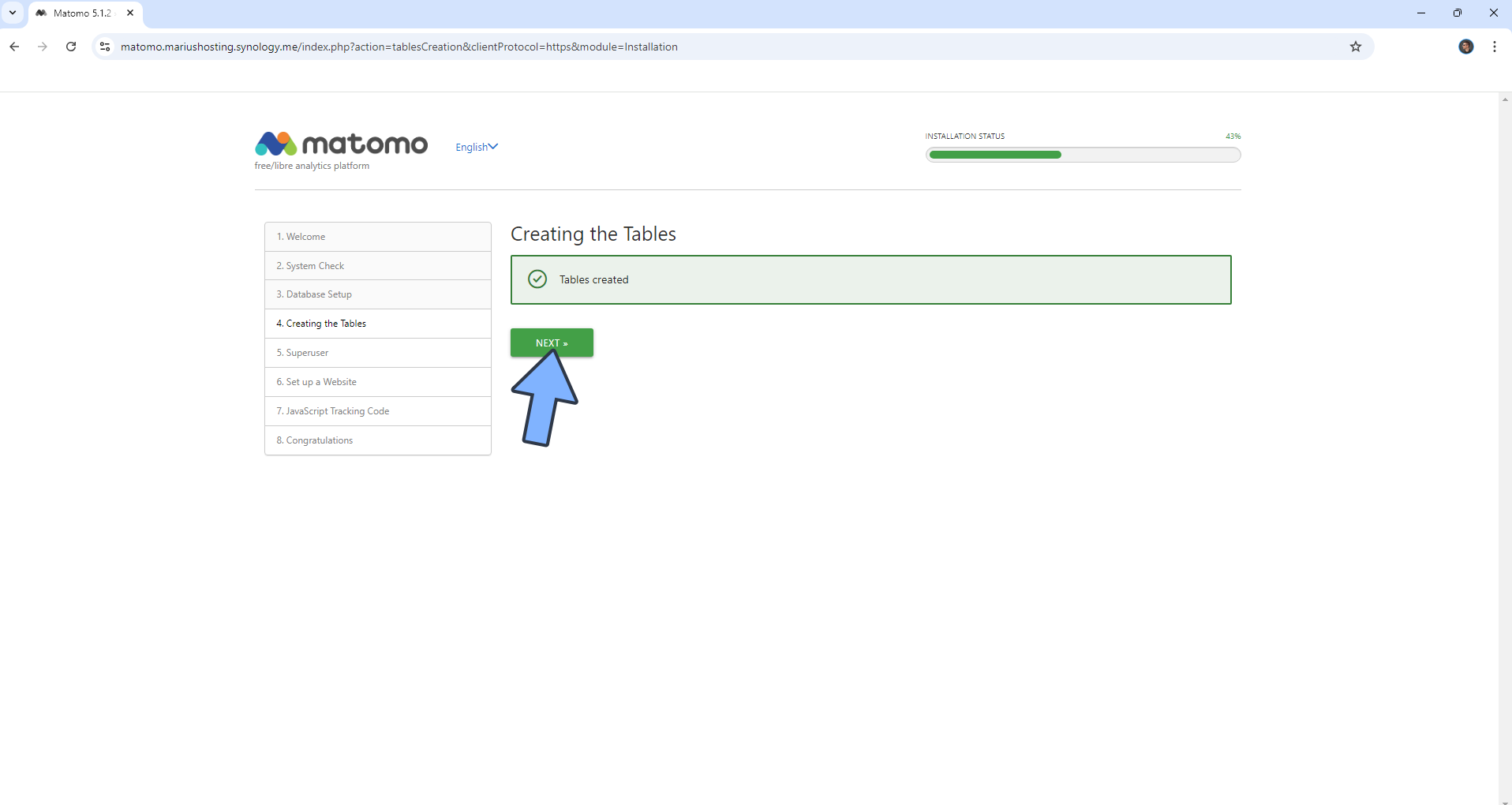
STEP 26
🟢Please Support My work by Making a Donation. Almost 99,9% of the people that install something using my guides forget to support my work, or just ignore STEP 1. I’ve been very honest about this aspect of my work since the beginning: I don’t run any ADS, I don’t require subscriptions, paid or otherwise, I don’t collect IPs, emails, and I don’t have any referral links from Amazon or other merchants. I also don’t have any POP-UPs or COOKIES. I have repeatedly been told over the years how much I have contributed to the community. It’s something I love doing and have been honest about my passion since the beginning. But I also Need The Community to Support me Back to be able to continue doing this work.
STEP 27
Add a Username, a Password and your Email address for your matomo instance. Click NEXT. Follow the instructions in the image below.

STEP 28
- Add your Website name
- Add your Website URL
- Select your Website time zone
Click NEXT. Follow the instructions in the image below.
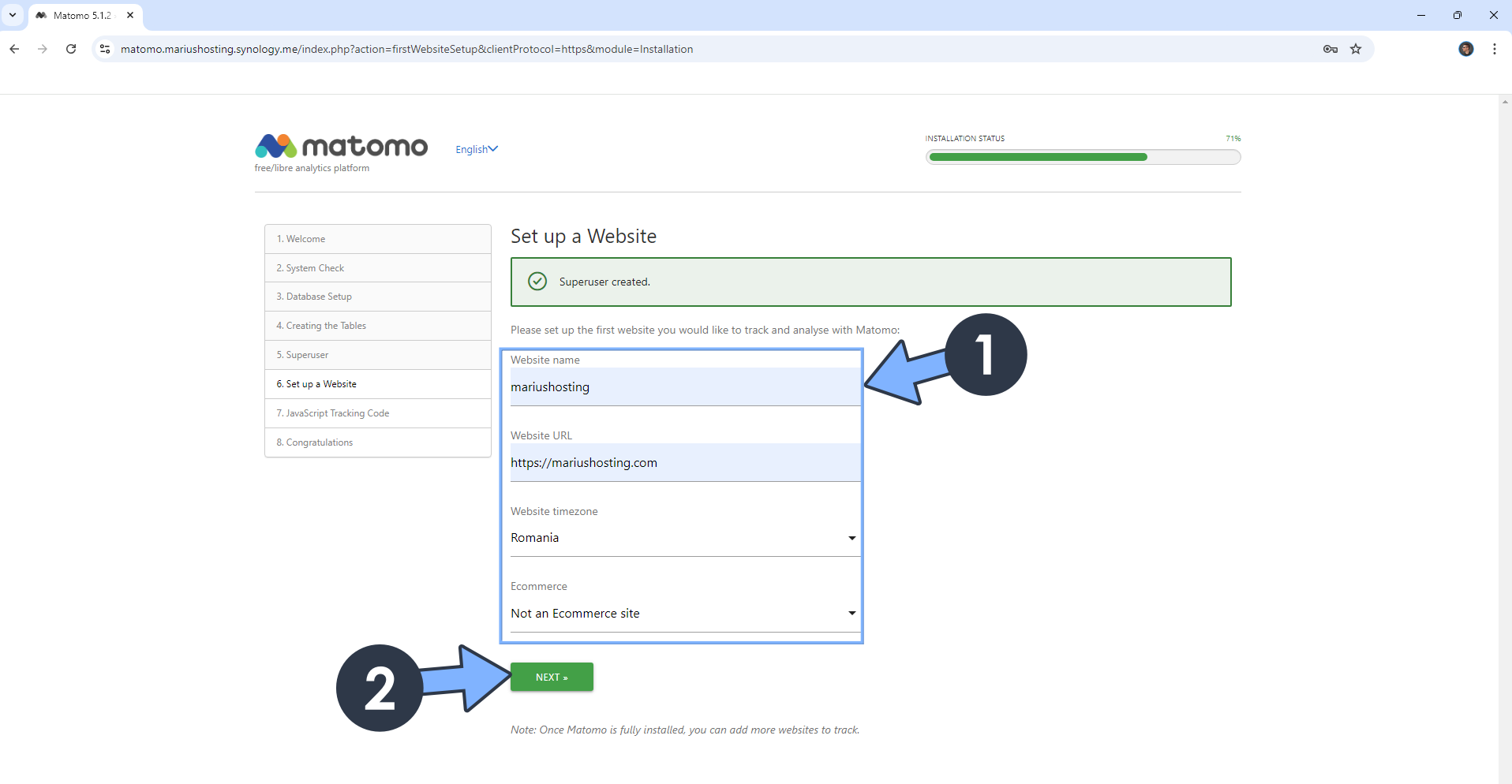
STEP 29
Copy your own JavaScript Tracking Code to a .txt file (you will need it later). Follow the instructions in the image below.

STEP 30
Scroll down on the page until you see the NEXT button. Click on it. Follow the instructions in the image below.
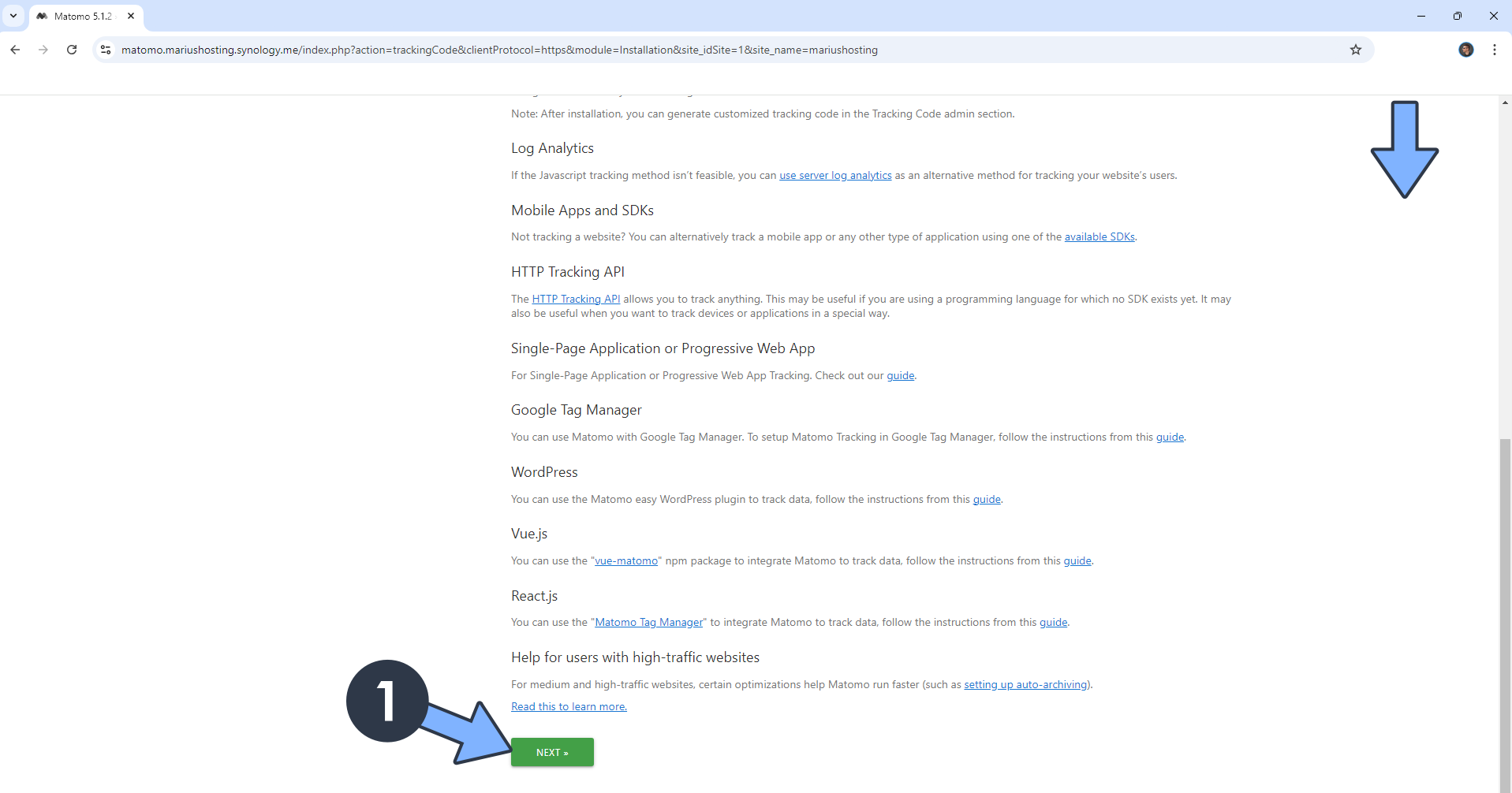
STEP 31
Click CONTINUE TO MATOMO. Follow the instructions in the image below.

STEP 32
Add the Username and Password you have previously created at STEP 27. Click SIGN IN. Follow the instructions in the image below.
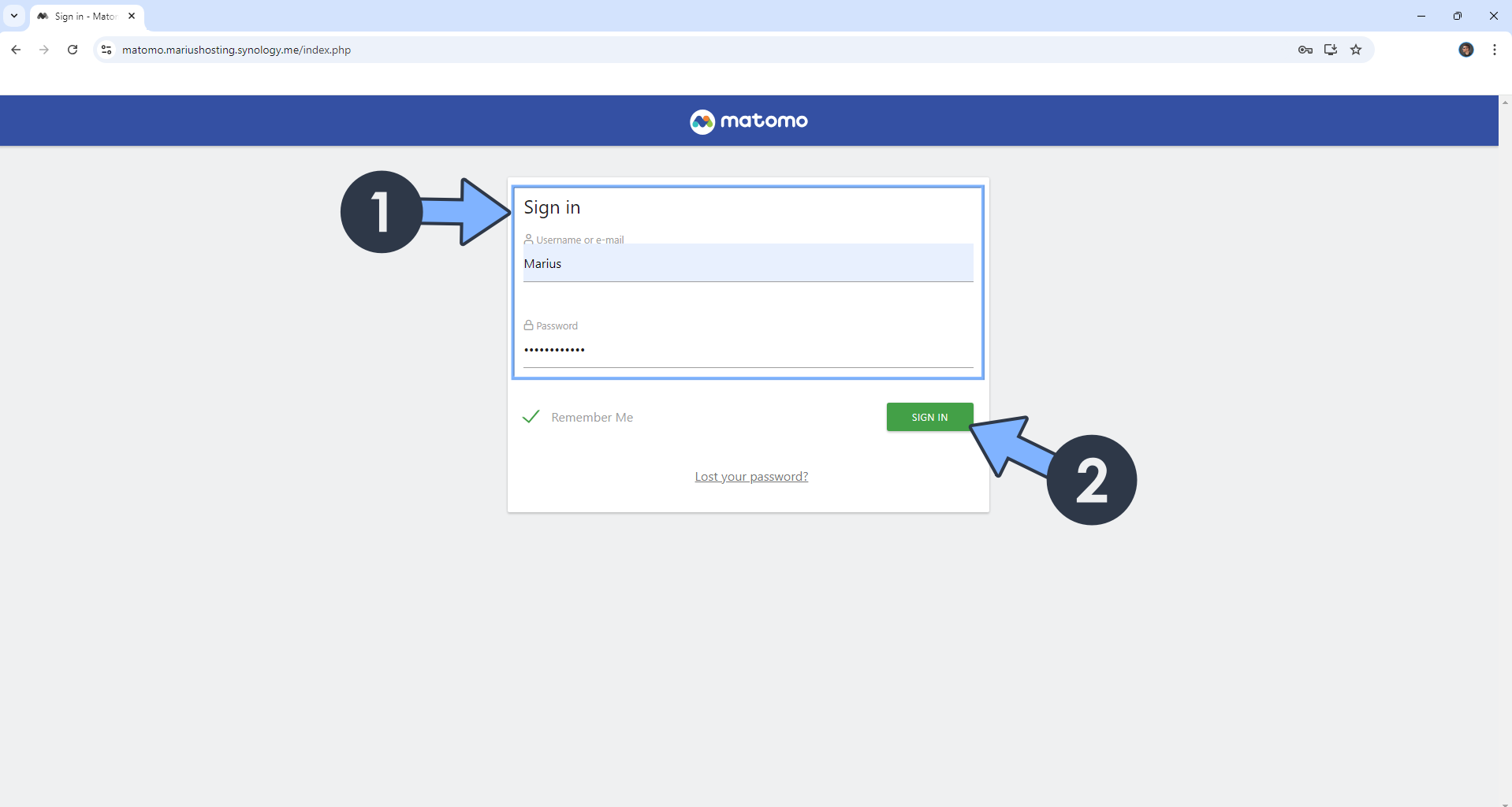
STEP 33
Your Matomo instance at a glance!

STEP 34
Paste your personal Matomo JavaScript Tracking code that you have automatically generated at STEP 29 on your website between the <head> and </head> tags of your site, then update your file. For example, I have a WordPress website hosted on a Synology NAS. If you have a WordPress website hosted elsewhere, know that the process is the same. Log into your WordPress admin Dashboard. On the left sidebar, click on “Theme Editor or Theme File Editor”. Select your theme, then search for the header.php file. Paste your personal Matomo JavaScript Tracking code that you have automatically generated at STEP 29 in the header.php file between the <head> and </head> tags of your site, then update your file. Follow the instructions in the image below.
Note: Paste the code in the website you have chosen at STEP 28. You can add multiple websites via the Matomo Dashboard later.

STEP 35
After the JavaScript code is added to your website, Matomo will start to collect Real-Time analytics of your website. My blog doesn’t have any TRACKING CODE on it. I just installed Matomo to show you how it works and how easily you can implement it on your website. I have already uninstalled it. Don’t forget to go back to STEP 1. I have worked hard for this guide so you can enjoy it.
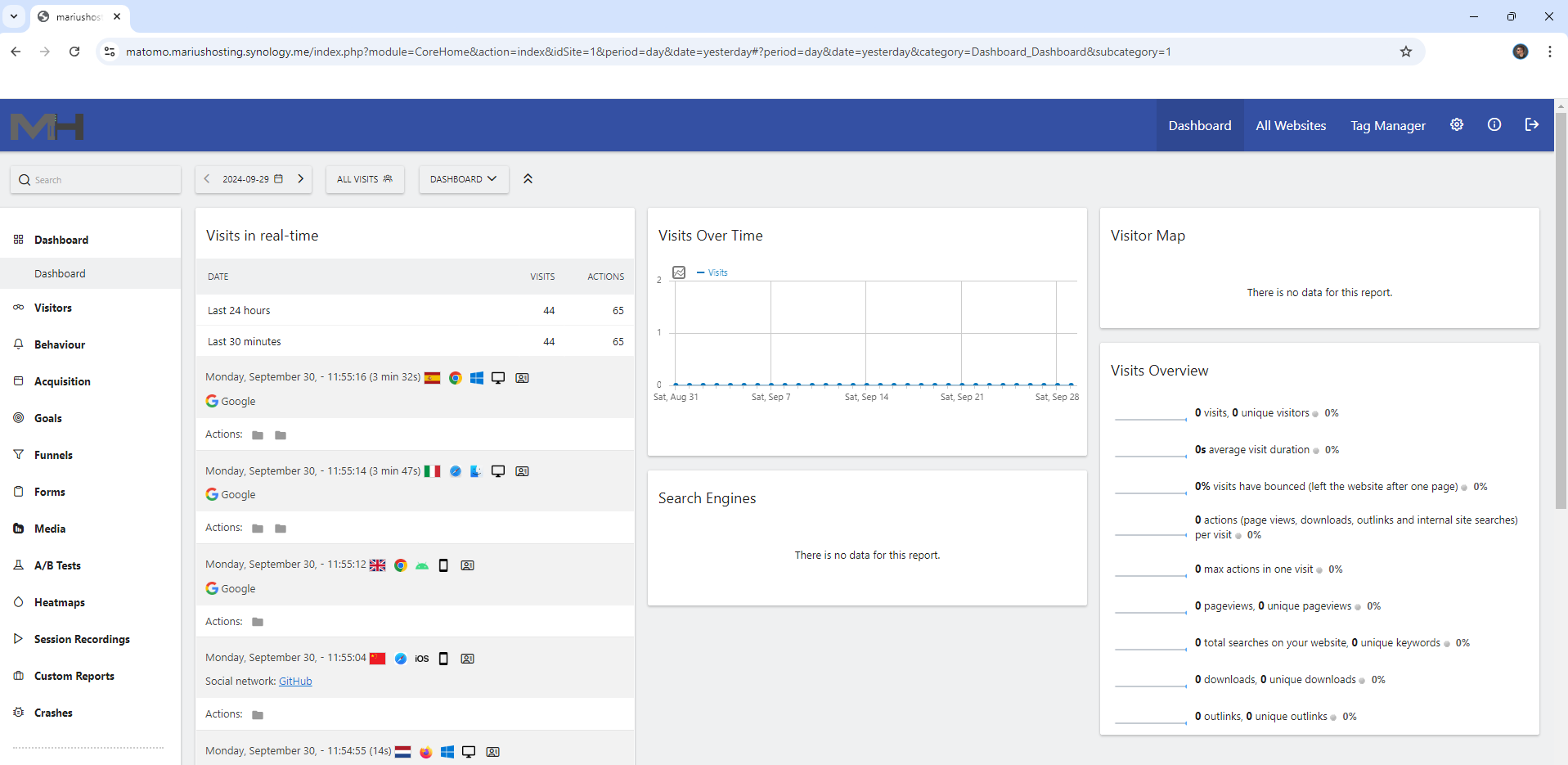
STEP 36
Install Text Editor via Synology “Package Center”. (Mandatory STEP.) If you already have Text Editor installed on your Synology NAS, skip this STEP.

STEP 38
Navigate under File Station in docker / matomo / data / config
Identify the config.ini.php file, then open it.
Under [database] add the following line: schema = Mariadb
Under [General] add the following line: force_ssl = 1
Click X to save the file. Follow the instructions in the image below.

STEP 39
Set Up Email Notifications on Matomo.
Enjoy Matomo!
If you encounter issues by using this container, make sure to check out the Common Docker issues article.
Note: Can I run Docker on my Synology NAS? See the supported models.
Note: How to Back Up Docker Containers on your Synology NAS.
Note: Find out how to update the Matomo container with the latest image.
Note: How to Free Disk Space on Your NAS if You Run Docker.
Note: Instead of the synology.me DDNS you can also use your own domain name.
Note: How to Schedule Start & Stop For Docker Containers.
Note: How to Activate Email Notifications.
Note: How to Add Access Control Profile on Your NAS.
Note: How to Change Docker Containers Restart Policy.
Note: How to Use Docker Containers With VPN.
Note: Convert Docker Run Into Docker Compose.
Note: How to Clean Docker.
Note: How to Clean Docker Automatically.
Note: Best Practices When Using Docker and DDNS.
Note: Some Docker Containers Need WebSocket.
Note: Find out the Best NAS Models For Docker.
Note: Activate Gmail SMTP For Docker Containers.
This post was updated on Tuesday / November 25th, 2025 at 2:29 PM
